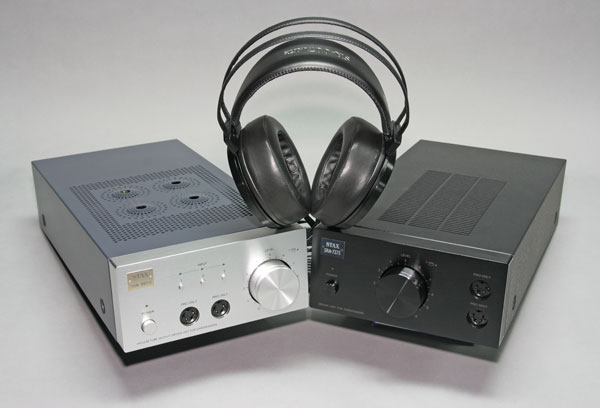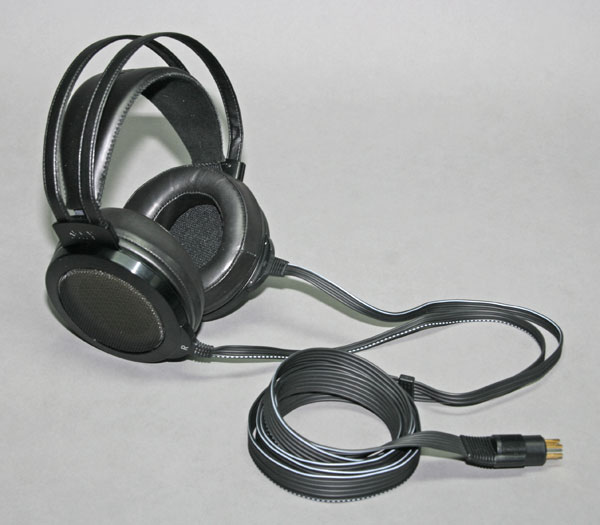Stax SR-007 MK2 Headphones

For most audiophiles, speakers are the last link in the signal chain before the music reaches their ears. But the acoustic interaction between the speakers and the room can cause all sorts of problems that are completely avoided by using headphones instead. And the ultimate headphones are widely considered to come from Japanese maker Stax, especially the flagship SR-007 MK2. Unlike most products I profile here, I actually got to try these amazing headphones for myself, and it was an experience not soon forgotten.

Whereas most headphones use drivers based on dynamic diaphragms, Stax uses electrostatic drivers much like electrostatic speakers—in fact, Stax calls its headphones "earspeakers." The company claims that this technology is better able to accurately reproduce the subtle nuances of music. New to the MK2 are real leather earpads that improve the comfort of extended listening.

All Stax headphones are designed to be used with their own, dedicated amplifier, and I got to try two different models with the SR-007 MK2. The SRM-007tII is a tube-based amp with one balanced input and two unbalanced inputs, one of which provides a loop output. Two headphone outputs on the front panel are joined by an input selector and volume knob with separate controls for the right and left channels.

I also got to try the SRM-727II solid-state amp, which provides one balanced and one unbalanced input with a loop output, but in this case, you must choose which input you want to listen to with a switch on the back. Two headphone outputs are provided along with a volume knob with separate right and left controls.

I spent quite a few wonderful hours listening to CDs, SACDs, and DVD-Audio discs on the SR-007 MK2, switching between the SRM-007tII and SRM-727II. The source was an Oppo BDP-83SE with its 2-channel analog outputs connected directly to the amps using Ultralink Audiophile MkII cables.

To my ears, there was only a hair's breadth of difference between the two amps. The bass was a bit more pronounced and richer on the tube-based SRM-007tII, while the solid-state SRM-727II sounded ever so slightly thinner and veiled.
You might think this would give the tubes an advantage, but in some cases, such as Sacred Feast by acapella choir Gaudeamus on SACD, the sound bloomed a bit too much in loud passages on the SRM-007tII. However, on other titles, such as Pink Floyd's Dark Side of the Moon, I preferred the slightly bigger sound of the tubes.
When I'm evaluating audio equipment, I always play my wife's CD, Living Through History, which I engineered and played all the wind instruments, so I know it very well. In this case, the tube amp sounded a bit bloated with slightly overblown bass, while the solid-state amp sounded crisper with better overall balance. Joanna's vocals sounded great on both.
I also listened to the standard Dolby Digital track of "New Frontier" from Donald Fagen's The Nightfly DVD-A, and I could hear an obvious difference between that and the 24-bit/48kHz PCM track—as you might expect, the Dolby Digital version was more brittle and less extended. On the high-res track, I could hear much deeper into the music than usual—for example, the background vocals were clear as a bell.
Just for grins, I played a bit of AAC-encoded audio from an iPod. The solid-state amp sounded a bit brittle, while the tube amp was smoother and warmer.
As a point of comparison, I listened to my Sony MDR-7506 studio headphones connected to a Pioneer Elite SC-05 receiver being fed by the Oppo via HDMI—and immediately wished I hadn't! They sounded pretty thin and weak after spending time with the Stax.
Tom Norton listened to a couple of tracks from a Chesky DVD-A sampler, including "Brick House" by Sara K. and "MacDougall's Men" by Rebecca Pidgeon. He preferred the tube amp, saying it sounded more open and detailed with tighter imaging on voices and bass—as he put it, there was "more there there." I couldn't disagree, at least on the tracks he heard.
I must say again that the differences between the amps mentioned here were extremely minor. In both cases, the imaging was superb, the frequency range was delightfully extended, and the nuances were artfully rendered. And the headphones themselves were incredibly comfortable to wear for long periods. Overall, it was a sublime listening experience, and I would have no problem owning either amp.
Well, I'd have one problem—the cost. A system with the SR-007 MK2 and SRM-007tII carries a price tag of $4220, while the cans with the SRM-727II is $4085. But if you want the very best sound you can get from headphones—in some situations, better than speakers can provide—this is clearly it.
- Log in or register to post comments




























































